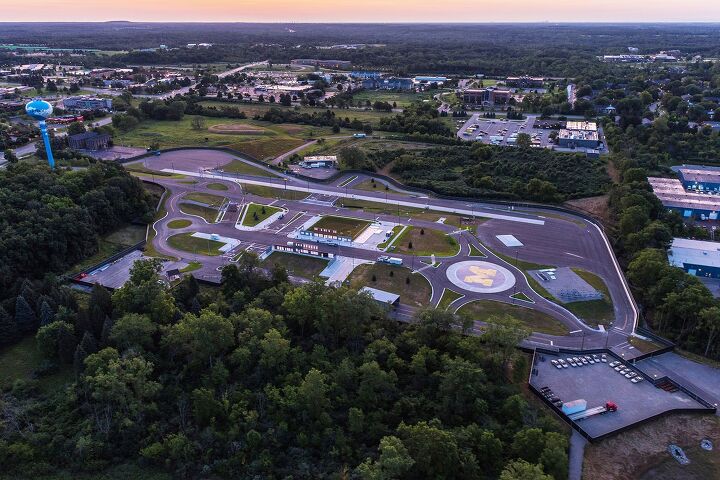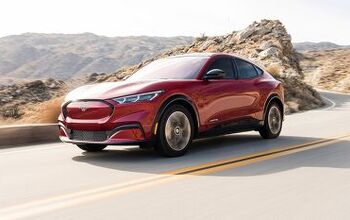Michigan to Stay Ahead of Silicon Valley With "Mcity" for Autonomous & Connected Car R&D

The facility was mostly deserted by the time I got there deliberately late to avoid politicians’ speechifying. Between the very realistic — but empty — roadways with functional traffic lights, railway crossings, and even parking meters, on one hand, and the two city blocks of obviously faux buildings, theatrical scrims really, on the other, I felt that at any second, things might switch to black and white and Rod Serling would step out from behind one of the backdrops.
I wasn’t in the Twilight Zone, though. I was on a gentle hillside on the north side of Ann Arbor.
While Serling’s landmark science fiction and fantasy show sometimes gave us a peek at what the future might look like, the 32 acre Mcity autonomous and connected vehicle research facility that opened yesterday on the University of Michigan’s north campus is definitely one of the places where the future of personal transportation will be made.
At first glance, Mcity does look more like a movie set than a high tech R&D installation and the $10 million that it cost to build doesn’t seem like much to an industry where it costs a billion dollars to develop a new car, but the facility’s promise is such that almost 50 private sector companies are partners in the project.
The fact that Mcity even exists is because of a unique partnership between the public and private sectors. The state of Michigan, via MDOT, put up $3 million, with UofM, a public university, also kicking in part of the construction costs. It looks like operational costs, at least for the next three years, will be covered by the private sector. Fifteen companies make up what is being called the Leadership Circle, which means they’ve each pledged $1 million to be paid out over three years. The Leadership Circle is a veritable who’s who of the industry including Ford, GM, Honda, Nissan, Toyota, Delphi, Denso, Bosch, Xerox, Verizon and Qualcomm. Another 32 firms have committed $150,000 each.
The members of the Leadership Circle aren’t being completely altruistic. That level of contribution gives those companies access to all the research that will be performed at the facility, regardless of who is doing or sponsoring the work.
That level of cooperation between car companies would not have been possible a generation or two ago, when the U.S. Dept. of Justice had automakers so worried about possible charges of collusion or violating anti-trust statutes that auto executives wouldn’t play golf with their counterparts for fear of an investigation. Of course, that level of cooperation will be necessary for the development of technical standards for vehicle to vehicle communication and other aspects of connected and autonomous driving.
The interest of the auto industry in Mcity is obvious — they can use it to test their tech. The interest of the University of Michigan is also pretty obvious. UoM’s engineering school has long had a very close relationship to the auto industry and the school wants to stay on the cutting edge along with their corporate partners. Mcity is part of the university’s Transportation Research Institute. The state of Michigan’s interest is keeping itself the global center of the auto industry.
With Elon Musk dissing “Detroit” at every opportunity (while staffing Tesla with engineers and designers with the domestic automakers on their resumes), tech behemoth Google testing a fleet of driverless cars, and even rumors of Apple getting into the car biz, there has been boasts from the West Coast and concerns from the rust belt that as computer technology becomes more and more important to how cars work Silicon Valley might displace Detroit as the center of innovation in the auto industry.
Mcity is the state of Michigan saying, “not so fast” to Silicon Valley. So far, it appears to be the only facility of its kind in the world.
The site is realistic down to the handicapped parking spaces and meters. So far no meter maids.
The test environment (Mcity is adverse to calling it a mere “test track”) is supposed to replicate “the broad range of complexities vehicles encounter in urban and suburban environments.” There are about five miles of roadways including, intersections, traffic signs and signals, sidewalks, benches, simulated buildings (both fixed and moveable), street lights, and obstacles such as construction barriers, “pedestrians”, and railroad crossings. A variety of road surfaces are used including concrete, asphalt and brick paving as well as metal grid and gravel surfaces. There’s a 1,000 foot straight along with a variety of curves and ramps with different radii. There are two, three and four lane roads as well as bike lanes and a roundabout. What looks like a covered bridge is supposed to simulate tunnels and overpasses. One street is covered overhead with netting to reproduce the shade from a canopy of trees. There are parallel and angle parked cars as well as mechanized bicycles, fire hydrants and both fixed and variable lighting and traffic control devices.
The Mcity facility is supported by the University of Michigan, the Michigan Dept. of Transportation, and about 50 corporate partners, including 15 “Leadership Circle” members that have each pledged $1 million.
While there are ramps and signs that look like they do on an interstate highway, there will be no high speed testing at the facility, despite the ‘road train’ of cars and trucks traveling in unison on a highway in Mcity’s animated promotional video. The top speed allowed at the facility is just 40 mph.
Mcity looks very modern and tidy. Everything follows the latest designs for roadways, etc. and I have to wonder how a car developed at Mcity might do in an urban area that’s a bit more vintage — like San Francisco or Rome. I wonder if Mcity has developed a protocol for dealing with New York City levels of litter.
Aerial photo and infographic courtesy of the University of Michigan. All other photos by the author.
Ronnie Schreiber edits Cars In Depth, a realistic perspective on cars & car culture and the original 3D car site. If you found this post worthwhile, you can get a parallax view at Cars In Depth. If the 3D thing freaks you out, don’t worry, all the photo and video players in use at the site have mono options. Thanks for reading – RJS

Ronnie Schreiber edits Cars In Depth, the original 3D car site.
More by Ronnie Schreiber
Latest Car Reviews
Read moreLatest Product Reviews
Read moreRecent Comments
- Zerofoo The green arguments for EVs here are interesting...lithium, cobalt and nickel mines are some of the most polluting things on this planet - even more so when they are operated in 3rd world countries.
- JMII Let me know when this a real vehicle, with 3 pedals... and comes in yellow like my '89 Prelude Si. Given Honda's track record over the last two decades I am not getting my hopes up.
- JMII I did them on my C7 because somehow GM managed to build LED markers that fail after only 6 years. These are brighter then OEM despite the smoke tint look.I got them here: https://www.corvettepartsandaccessories.com/products/c7-corvette-oracle-concept-sidemarker-set?variant=1401801736202
- 28-Cars-Later Why RHO? Were Gamma and Epsilon already taken?
- 28-Cars-Later "The VF 8 has struggled to break ground in the increasingly crowded EV market, as spotty reviews have highlighted deficiencies with its tech, ride quality, and driver assistance features. That said, the price isn’t terrible by current EV standards, starting at $47,200 with leases at $429 monthly." In a not so surprising turn of events, VinFast US has already gone bankrupt.










































Comments
Join the conversation
"Michigan to Stay Ahead of Silicon Valley with “Mcity” for Autonomous & Connected Car R&D" LOL, no. That's not how this works. It's a useful facility for companies anywhere who's willing to put their test vehicle on a car and drive it there. Tesla and Google seem to be focusing on making the car react to what it sees, rather than on the connected car. Here's what Google wants to tell the public: http://www.ted.com/talks/chris_urmson_how_a_driverless_car_sees_the_road?language=en Here's what Tesla wants to tell the public: https://www.youtube.com/watch?v=7quu551ehc0 The connected car is a "nice to have" for these guys. I haven't seen anything comparable from the old-school auto folks.
Guy in that hacked Cherokee had an autonomous car for a while.